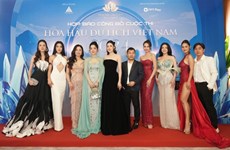Arabic calligraphy on show
Though many people don't understand what the Arabic words mean, they can
still find the Arabic calligraphy in a new Hanoi University of
Languages and International Studies (ULIS) exhibition beautiful.
Though many people don't understand what the Arabic words mean, they can
still find the Arabic calligraphy in a new Hanoi University of
Languages and International Studies (ULIS) exhibition beautiful.
The first ever exhibition of Arabic calligraphy in Vietnam opens on December 18 in Hanoi. It commemorates World Arabic Language Day on December 18, established by UNESCO in 2012 to highlight Arabic's importance as of the UN's official languages.
Presented by the Egyptian Embassy and ULIS, the exhibition would help enhance cultural exchange, and mutual understanding between Vietnam and Egypt, said Ambassador Youssef K Hanna. It would also promote Arabic teaching at the university.
Nguyen Thu Lan, one of about 60 students learning Arabic at ULIS, said she finds the exhibition beautiful and interesting, despite not knowing all the words.
"I have been learning Arabic for a short time and don't know every word, but I understand that most of the calligraphic works express tribute and respect to Allah," she said.
"The artworks look like wonderful paintings, as the calligraphers combine writings with fine arts. They decorate the writings with patterns of natural elements and colourful drawings."
Arabic calligraphy is the artistic practice of handwriting, based on the Arabic language and alphabet and originating in lands sharing a common Islamic and Arabic cultural heritage.
"It is known in Arabic as ‘khatt', which is derived from the word ‘line', ‘design' or ‘construction'," Hanna said. "The Arabic calligrapher's traditional instrument is the ‘qalam', a pen made of dried reed or bamboo. The ink is often coloured, and its intensity can vary greatly, so the greater strokes of the compositions can be very dynamic."
Religious significance
Most works of Arabic calligraphy have religious significance based on verses from the Qu'ran – the Muslim holy book.
So these works are usually used at home and worship places for obtaining blessings, as well as for decorating purposes.
They also include words about wisdom, luck and happiness, and the Egyptians use this kind of art at their homes or stores to bring in peace and prosperity.
The exhibition showcases 24 artworks by Egyptian calligraphers Mostafa Khoder, Ahmed Abdel Baset, Hamdy Zayed, and Mohamed Youssef Elmaghraby.
Elmaghraby is one of the most renowned calligraphers in Egypt, having participated in many local and international exhibitions. He also teaches Arabic calligraphy in various schools and universities.
"It's wonderful that I have the chance to introduce the beauty and value of Arabic calligraphy to Vietnam, where Arabic is not a popular language and very few people learn it," Elmaghraby said.
"I expect that the exhibition will help increase awareness about the importance of learning Arabic, for further mutual understanding of cultural heritage between Vietnam and Arab countries. I believe the easiest way to understand a nation is to learn its language."
The exhibition will run in two days at ULIS, 144 Xuan Thuy street, Hanoi.-VNA
The first ever exhibition of Arabic calligraphy in Vietnam opens on December 18 in Hanoi. It commemorates World Arabic Language Day on December 18, established by UNESCO in 2012 to highlight Arabic's importance as of the UN's official languages.
Presented by the Egyptian Embassy and ULIS, the exhibition would help enhance cultural exchange, and mutual understanding between Vietnam and Egypt, said Ambassador Youssef K Hanna. It would also promote Arabic teaching at the university.
Nguyen Thu Lan, one of about 60 students learning Arabic at ULIS, said she finds the exhibition beautiful and interesting, despite not knowing all the words.
"I have been learning Arabic for a short time and don't know every word, but I understand that most of the calligraphic works express tribute and respect to Allah," she said.
"The artworks look like wonderful paintings, as the calligraphers combine writings with fine arts. They decorate the writings with patterns of natural elements and colourful drawings."
Arabic calligraphy is the artistic practice of handwriting, based on the Arabic language and alphabet and originating in lands sharing a common Islamic and Arabic cultural heritage.
"It is known in Arabic as ‘khatt', which is derived from the word ‘line', ‘design' or ‘construction'," Hanna said. "The Arabic calligrapher's traditional instrument is the ‘qalam', a pen made of dried reed or bamboo. The ink is often coloured, and its intensity can vary greatly, so the greater strokes of the compositions can be very dynamic."
Religious significance
Most works of Arabic calligraphy have religious significance based on verses from the Qu'ran – the Muslim holy book.
So these works are usually used at home and worship places for obtaining blessings, as well as for decorating purposes.
They also include words about wisdom, luck and happiness, and the Egyptians use this kind of art at their homes or stores to bring in peace and prosperity.
The exhibition showcases 24 artworks by Egyptian calligraphers Mostafa Khoder, Ahmed Abdel Baset, Hamdy Zayed, and Mohamed Youssef Elmaghraby.
Elmaghraby is one of the most renowned calligraphers in Egypt, having participated in many local and international exhibitions. He also teaches Arabic calligraphy in various schools and universities.
"It's wonderful that I have the chance to introduce the beauty and value of Arabic calligraphy to Vietnam, where Arabic is not a popular language and very few people learn it," Elmaghraby said.
"I expect that the exhibition will help increase awareness about the importance of learning Arabic, for further mutual understanding of cultural heritage between Vietnam and Arab countries. I believe the easiest way to understand a nation is to learn its language."
The exhibition will run in two days at ULIS, 144 Xuan Thuy street, Hanoi.-VNA













